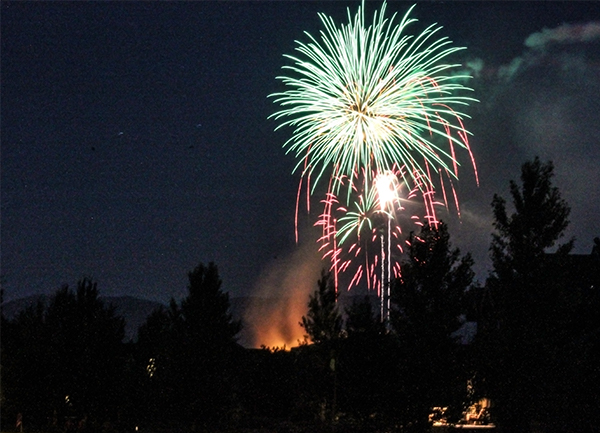By Christine Osborne

For many people, the Fourth of July wouldn’t BE the Fourth of July without fireworks. But these pyrotechnic displays also produce high concentrations of smoke and particulates (PM) that can harm our air quality and pose a risk to individuals who are sensitive to particulate pollution. And professional displays aren’t the only source of PM pollution — smaller gatherings of neighbors or families lighting fireworks can also contribute to a decrease in an area’s short-term air quality and pose particular health risks to those living nearby.
The 2018 Utah legislature passed HB38 to limit the number of days Utahns can shoot individual fireworks. Under the new law, people will be able to legally use fireworks between July 2-5 and July 22-25. It also gives cities the power to ban fireworks in certain areas depending on fire hazards. While this is good news for our overall air quality during the summer, it still means there will still be days when the PM pollution spikes as holiday celebrations get underway.
Fireworks
Fireworks smoke is largely composed of two types of particulate matter: course particulates (PM10) and fine particulates (PM2.5). Short-term exposure to fine particle pollution can pose health concerns, particularly for children, older adults, and those with respiratory conditions. This smoke can aggravate lung disease, cause asthma attacks and acute bronchitis, and may also increase susceptibility to respiratory infections. In people with heart disease, short-term exposures have been linked to heart attacks and arrhythmias.
Particulates aren’t the only pollutants linked to fireworks. From the sulfur and potassium in the gunpowder that powers them to the heavy metals that provide the explosions of color, fireworks contain a potent blend of toxic compounds. Although perchlorate, an oxidizer that fuels the reaction, tends to dissipate during combustion, remnants can still be found on the soil and water after fireworks shows. Heavy metals supply the colors we associate with fireworks shows– barium for glistening greens, lithium and strontium compounds for bursts of red, copper for flashes of blue, and aluminum for dazzling white. These metals can be inhaled or make their way into the water and soil. While one fireworks display is unlikely to cause lasting health effects, repeated exposure can be problematic.
Division of Air Quality (DAQ) monitors consistently show extremely high short-term concentrations of PM10 and PM2.5 associated with fireworks. In fact, Ogden City’s worst air day doesn’t occur in the winter — it happens on July 4, when particulate concentrations can jump to 20 times higher than normal. These readings are in line with research on the impacts fireworks have on air quality nationwide. A 2015 study by the National Oceanic and Atmospheric Administration (NOAA) quantified the spike in fine particulate matter on July 4 using observations from 315 U.S. air-quality monitoring sites over a 14-year period. The research showed that the average concentrations of particulates over the 24-hour period beginning at 8 p.m. on July 4 were 42 percent greater than on the days before and after the holiday.
While the Environmental Protection Agency (EPA) allows states to classify air-quality exceedances from fireworks as exceptional events for regulatory reporting purposes, high particulate levels still impact health over the short-term. These health impacts increase if elevated ozone levels or wildfire smoke are also present.
DAQ recommends that individuals affected by fine particulate pollution avoid fireworks displays or view them from a safe distance. Those who are particularly sensitive may want to stay indoors, especially during the evening, and close the windows so that indoor air is not affected.
Wildfires

This summer, as in previous summers, fireworks pose an additional threat to air quality: wildfires. Wildfire smoke is composed of a complex mixture of gases, fine particles, and water vapor that form when organic matter burns. Particulates from smoke are a mixture of solid particles—pieces of wood and other burning solids—and liquid droplets. As with fireworks smoke, the biggest health threat from wildfire smoke comes from fine particles.
We want everybody to have a safe and healthy Fourth of July. Consider alternative ways to celebrate the holidays with your family and friends and be mindful of the impacts fireworks have on the air we all breathe.
We provide hourly air-quality monitoring, a three-day action forecast, and health forecast on our website and our UtahAir app, available for free for Apple and Android mobile devices. For up-to-date information on the air-quality impacts from wildfires, visit Utah Fire Info or the NOAA website for real-time forecasts on the emissions and smoke transport from wildfires in Utah and neighboring states.
I am a content strategist/communication specialist at the Utah Department of Environmental Quality. I have a Masters in Strategic Communication (MSC) degree from Westminster College and earned my Accreditation in Public Relations (APR) from the Public Relations Society of America (PRSA). I currently teach Integrated Marketing Communication to graduate students in the MSC program at Westminster. In a previous life, I was a bassoonist with the Utah Symphony for 26 years. I love to hike, bike, camp, read, garden, geek out on all things science, and spend time with two college-age sons. I volunteer with a number of local refugee organizations and am currently a teen mentor with the 4-H New American Goat Club and Teen Leadership Club.

